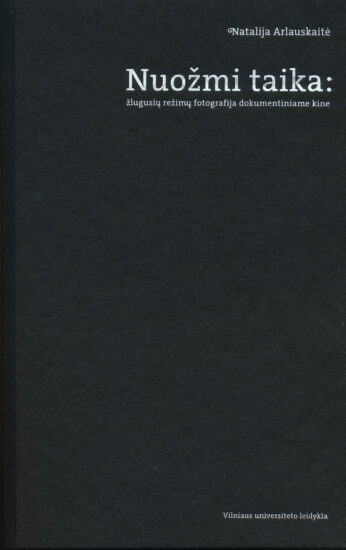Natalija Arlauskaitė. Severe Peace: Photography of Collapsed Regimes in Documentary Cinema

ARTS AND LITERATURE
Natalija Arlauskaitė, Severe Peace: Photography of Collapsed Regimes in Documentary Cinema (Nuožmi taika: žlugusių režimų fotografija dokumentiniame kine), Vilnius: Vilnius University Press, 2020, 328 pp.
The latest decade-long research by Vilnius University professor Natalija Arlauskaitė explores complex topics – what part the historical photography of collapsed regimes plays in documentary cinema, how it is re-created and used, what new formations and artworks it creates. Using photos taken from the archives of repressive institutions and private family albums, the author analyzes how, after the collapse of repressive regimes, documentary, archival animation, and visual mixed media art reflect on history, on our tense relationship with a difficult and painful past. And in general, how does visuality become a tool of power and begin to participate in the mechanism of political power, and vice versa – how does ideology function in visual registers? How can we recognize the state by looking at photos from the past? How can individual artistic strategies be discussed in order to reveal, by means of them, a more general picture of political and historical imagination? Examples of Lithuanian documentary and visual art are discussed in the book alongside documentary film, animation, and contemporary art projects from Portugal, Cambodia, Russia, Finland, Germany, and Poland that also include photographic archives.
As the name suggests, this is a severe book. During the presentation of her book, Arlauskaitė spoke about the mystery of the title and revealed that “the word ’severe’ comes from the peace treaty between the Soviet Union and Finland, signed in 1940 after the Winter War. Finland was subjected to very demanding treaty terms alongside the peace, so when we talk about this peace treaty, we are talking about a severe peace, a difficult reconciliation.“ In the case of Arlauskaitė’s book, the metaphor of severe peace takes part in the exploration of the ways in which photographic documents of the past are neither written off nor decontaminated or disqualified; how, by reflecting on these documents, a way to quench the tension with the past is found, making it thinkable and open for reflection. It is worth saying that the book is rather severe in its design too – as if in negative photographs, white letters are displayed here on a black background, and illustrations turned into postcards are squeezed to fit in on the pages. Thus, the book is not only visually complemented but also gives a nod to the tradition of academic publishing by asking in what form may academic research be presented?
Natalija Arlauskaitė – researcher of literature, visuality, and film, professor at the Institute of International Relations and Political Science at the University of Vilnius. Her key areas of interest are visual and media theory, historical imagination, Soviet studies, and memory of the World War II. She is the author of multiple books including ’Analysis of Hermetic Text: The Structure of the Semantic Space of Velimir Khlebnikov’s Works’ (2005), ’Key-concepts of Feminist Film Theory’ (2010), ’Local and Foreign Olympuses: Film Adaptation between Narratology and Cultural Criticism’ (2014).